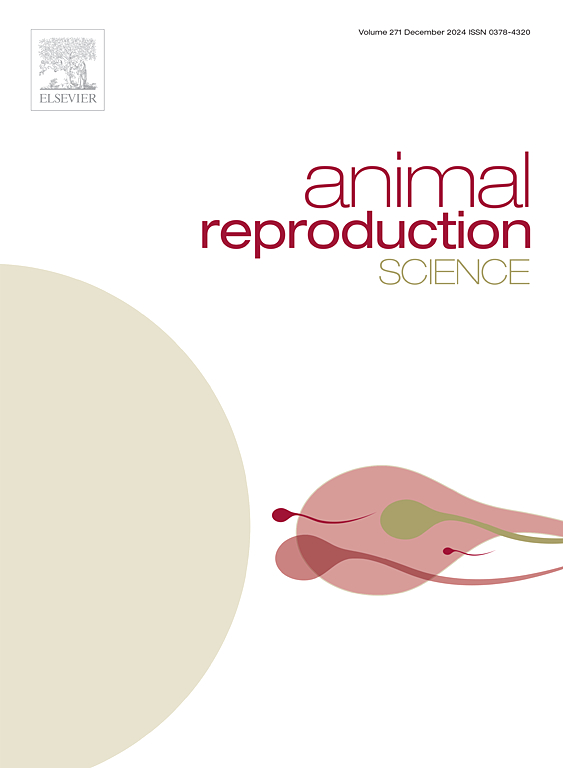Transcriptome analysis of the ovary and testis of the pearl oyster Pinctada fucata: Identification of genes and pathways involved in gonadal development
IF 2.2
2区 农林科学
Q1 AGRICULTURE, DAIRY & ANIMAL SCIENCE
引用次数: 0
Abstract
Pinctada fucata is a commercially vital species in global pearl aquaculture, producing high-quality pearls. To investigate the molecular regulatory mechanisms of gonadal development in P. fucata, transcriptome analysis was employed to compare expression profiles between testis and ovary across four key developmental stages. A total of 56.86 Gb of clean data was generated, including 392,510 circular consensus sequencing reads, among which 292,295 full-length non-chimeric (FLNC) sequences were identified. A transcript clustering analysis of FLNC reads revealed 89,645 high-quality consensus sequences. 17,646 gene loci were identified, including 8588 novel loci and 28,121 newly discovered transcripts, of which 17,350 were successfully annotated. The boundaries of 12,040 genes on the chromosomes were corrected, and 10,761 complete open reading frame sequences. 281 genes related to gonadal development were identified, including 186 genes with full-length cDNAs in the PacBio library. The study found that HUS1-like, MAD2A-X1, and BLM were stage-specifically upregulated during ovarian maturation, ensuring the accuracy of meiosis. Meanwhile, NR0B1, ETV7L-X5, and CAPRIN1-X2 promoted testicular maturation by regulating somatic cell differentiation and the germ cell microenvironment. KEGG enrichment analysis identified key pathways involved in gonadal development, including the ribosome, oxidative phosphorylation, DNA replication, and lysosome. Fatty acid metabolism was linked to ovarian maturation, while the FoxO and ErbB signaling pathways were associated with testicular maturation. These findings offer valuable insights into the molecular mechanisms regulating gonadal development in P. fucata and enhance genomic resources for this economically important species.
fucata珍珠牡蛎卵巢和睾丸的转录组分析:参与性腺发育的基因和途径的鉴定
fucata是全球珍珠养殖的重要商业品种,生产高品质的珍珠。为了研究富卡塔鱼性腺发育的分子调控机制,利用转录组分析比较了四个关键发育阶段睾丸和卵巢的表达谱。共获得56.86 Gb的干净数据,包括392,510个圆形共识测序reads,其中鉴定出292,295个全长非嵌合(FLNC)序列。FLNC reads的转录本聚类分析显示89,645个高质量的一致序列。共鉴定出17646个基因位点,其中新发现基因位点8588个,新发现转录本28121个,成功注释17350个。校正了12,040个染色体上的基因边界,完成了10,761个开放阅读框序列。共鉴定出281个 与性腺发育相关的基因,其中PacBio文库中含有186个全长cdna的基因。研究发现,在卵巢成熟过程中,HUS1-like、MAD2A-X1和BLM均有分期特异性上调,从而保证了减数分裂的准确性。同时,NR0B1、ETV7L-X5和CAPRIN1-X2通过调节体细胞分化和生殖细胞微环境促进睾丸成熟。KEGG富集分析确定了参与性腺发育的关键途径,包括核糖体、氧化磷酸化、DNA复制和溶酶体。脂肪酸代谢与卵巢成熟有关,而FoxO和ErbB信号通路与睾丸成熟有关。这些发现为研究富卡塔鱼性腺发育的分子机制提供了有价值的见解,并增加了这一重要经济物种的基因组资源。
本文章由计算机程序翻译,如有差异,请以英文原文为准。
求助全文
约1分钟内获得全文
求助全文
来源期刊

Animal Reproduction Science
农林科学-奶制品与动物科学
CiteScore
4.50
自引率
9.10%
发文量
136
审稿时长
54 days
期刊介绍:
Animal Reproduction Science publishes results from studies relating to reproduction and fertility in animals. This includes both fundamental research and applied studies, including management practices that increase our understanding of the biology and manipulation of reproduction. Manuscripts should go into depth in the mechanisms involved in the research reported, rather than a give a mere description of findings. The focus is on animals that are useful to humans including food- and fibre-producing; companion/recreational; captive; and endangered species including zoo animals, but excluding laboratory animals unless the results of the study provide new information that impacts the basic understanding of the biology or manipulation of reproduction.
The journal''s scope includes the study of reproductive physiology and endocrinology, reproductive cycles, natural and artificial control of reproduction, preservation and use of gametes and embryos, pregnancy and parturition, infertility and sterility, diagnostic and therapeutic techniques.
The Editorial Board of Animal Reproduction Science has decided not to publish papers in which there is an exclusive examination of the in vitro development of oocytes and embryos; however, there will be consideration of papers that include in vitro studies where the source of the oocytes and/or development of the embryos beyond the blastocyst stage is part of the experimental design.
 求助内容:
求助内容: 应助结果提醒方式:
应助结果提醒方式:


